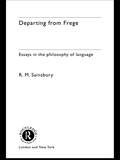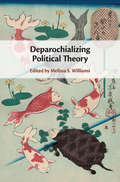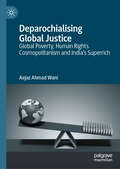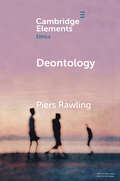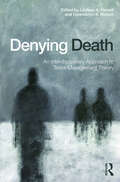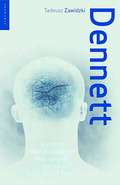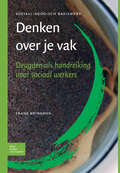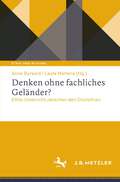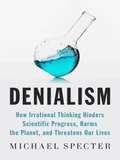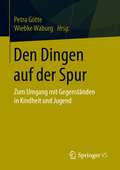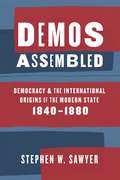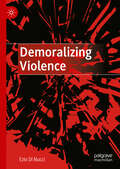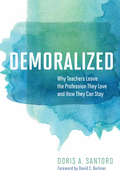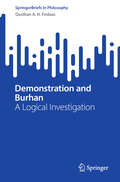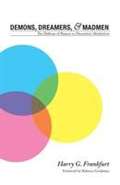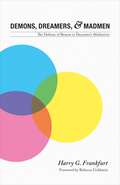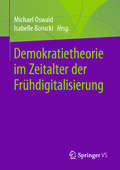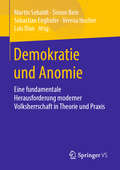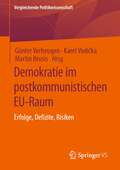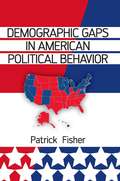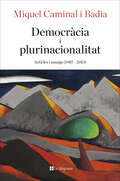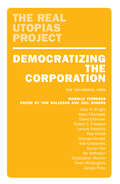- Table View
- List View
Departing from Frege: Essays in the Philosophy of Language (International Library of Philosophy)
by Mark SainsburyFrege is now regarded as one of the world's greatest philosophers, and the founder of modern logic. Mark Sainsbury argues that we must depart considerably from Frege's views if we are to work towards an adequate conception of natural language. This is an outstanding contribution to philosophy of language and logic and will be invaluable to all those interested in Frege and the philosophy of language.
Deparochializing Political Theory
by Melissa S. WilliamsIn a world no longer centered on the West, what should political theory become? Although Western intellectual traditions continue to dominate academic journals and course syllabi in political theory, up-and-coming contributions of 'comparative political theory' are rapidly transforming the field. Deparochializing Political Theory creates a space for conversation amongst leading scholars who differ widely in their approaches to political theory. These scholars converge on the belief that we bear a collective responsibility to engage and support the transformation of political theory. In these exchanges, 'deparochializing' political theory emerges as an intellectual, educational and political practice that cuts across methodological approaches. Because it is also an intergenerational project, this book presses us to re-imagine our teaching and curriculum design. Bearing the marks of its beginnings in East Asia, Deparochializing Political Theory seeks to de-center Western thought and explore the evolving tasks of political theory in an age of global modernity.
Deparochialising Global Justice: Global Poverty, Human Rights Cosmopolitanism and India’s Superrich
by Aejaz Ahmad WaniThis book offers a deparochial account of global justice and addresses disenchantment stemming from its West-centricity and provincial theoretical formulations. As the recurring global poverty debate restricts the duties of alleviating poverty and inequality to the developed world, this book attempts to broaden the spectrum of duties to the superrich of the developing world. Drawing from the case study of India’s superrich as an exemplar of the potent agency of rising powers, the book examines the structural relationship between unbridled affluence and the (un)realisation of the human rights of the poor. It contends that India’s superrich, like their counterparts in other powerful developing countries, both contribute as well as benefit from the highly decentralised global economic order that (re)produces affluence of the few and deprivation of the many within these countries. In doing so, this book argues that the superrich have a positive duty to alleviate poverty and reduce inequality beyond their free-standing moral responsibility for philanthropy.
Deontology (Elements in Ethics)
by Piers RawlingDeontology is a theory about how we should act, morally speaking. It comes in several varieties, but all share certain doctrines, many of which are close to those found in the so-called 'common-sense morality' of the Western world. And all varieties are united in their opposition to consequentialism, a theory that, in its simplest form, tells us that we should always act so as to maximize impersonal value by bringing about the best consequences. This Element presents some of the different versions of deontology, including the views of W. D. Ross, and, to a lesser extent, Immanuel Kant. It defends certain deontological tenets, while challenging others, and contrasts them with consequentialism. Deontology and consequentialism are two of the main contenders in ethical theory, but virtue ethics is another, and it too is addressed (briefly), with an attempt to see it, in its most plausible form, as part of deontology.
Deontic Logic and Legal Systems
by Pablo E. Navarro Jorge L. RodrÍguez Eugenio Bulygin Pablo E. Navarro Jorge L. RodríguezA considerable number of books and papers have analyzed normative concepts using new techniques developed by logicians; however, few have bridged the gap between the Continental (i. e. , European) and Latin American traditions in legal philosophy. This book addresses this issue by offering an introductory study on the many possibilities that logical analysis offers the study of legal systems. The volume is divided into two sections: The first covers the basic aspects of classical and deontic logic and its connections, advancing an explanation of the most important topics of the discipline by comparing different systems of deontic logic and exploring some of the most important paradoxes in its domain. The second section deals with the role of logic in the analysis of legal systems by discussing in what sense deontic logic and the logic of norm-propositions are useful tools for a proper understanding of the systematic structure of law. Arguments are provided to stress the relevance of a systematic reconstruction of law as a necessary step in the identification of the truth conditions of legal statements and the reasons for accepting or rejecting the validity of logical consequences of enacted legal norms.
Denying Death: An Interdisciplinary Approach to Terror Management Theory (The\enlightenment World Ser.)
by Lindsey A. Harvell Gwendelyn S. NisbettThis volume is the first to showcase the interdisciplinary nature of Terror Management Theory, providing a detailed overview of how rich and diverse the field has become since the late 1980s, and where it is going in the future. It offers perspectives from psychology, political science, communication, health, sociology, business, marketing and cultural studies, among others, and in the process reveals how our existential ponderings permeate our behavior in almost every area of our lives. It will interest a wide range of upper-level students and researchers who want an overview of past and current TMT research and how it may be applied to their own research interests.
Denying Death: An Interdisciplinary Approach to Terror Management Theory
by Lindsey A. Harvell Gwendelyn S. NisbettThis volume is the first to showcase the interdisciplinary nature of Terror Management Theory, providing a detailed overview of how rich and diverse the field has become since the late 1980s, and where it is going in the future. It offers perspectives from psychology, political science, communication, health, sociology, business, marketing and cultural studies, among others, and in the process reveals how our existential ponderings permeate our behavior in almost every area of our lives. It will interest a wide range of upper-level students and researchers who want an overview of past and current TMT research and how it may be applied to their own research interests.
Dennett
by Tadeusz ZawidskiTadeusz Zawidzki outlines Dennett's reconciliation of three major components-thought, consciousness, and freedom of the will-with what science tells us about human nature. In the course of this exposition, the book highlights the important role that Darwinian thinking plays in Dennett's proposed reconciliation, as well as his innovative proposals regarding the 'reality' of our consciousness and its attributes.
Denken over je vak: Deugden als handreiking voor sociaal werkers (Sociaal agogisch basiswerk)
by BSL Fictief F. BrinkmanHet belangrijkste instrument dat sociaal werkers hebben, zijn zij zelf. Het vak vraagt dan ook als geen ander om bespiegeling. Nadenken over je vak kan je op vier punten verder helpen; je leert hoe je moet handelen, je verbetert je handelen, je kunt omgaan met frustraties en je weet wat ervoor zorgt dat je plezier in je werk houdt. In je eentje kom je ver, maar niet ver genoeg. Andere mensen kunnen je helpen je zelfonderzoek te verdiepen en te verfijnen. Omgekeerd kun jij anderen helpen. Het ligt daarom voor de hand reflectie te verbinden met communicatie en handelen. Denken over je vak, deugden als handreiking voor sociaal werkers gaat daarom niet alleen over denken maar ook over doen. Concreet helpt dit boek je vragen te stellen over kwaliteiten in je werk én daarop antwoorden te formuleren. Het stelt de aloude deugdenleer voor als instrument waarmee (aankomend) professionals hun positie kunnen bepalen, accenten leggen en keuzes maken. Deugdzaamheid is daarbij klankbord, richtingaanwijzer en toetssteen. Brinkman koppelt deugden aan de leercirkel van ervaren, overdenken, ontwerpen, testen en weer ervaren. Hij geeft ze daarmee herkenbare praktijktoepassingen. Hieromheen vindt de lezer veel begrippen uit filosofie en sociologie die het denken over het vak inhoud en structuur geven. Studievragen en columns nodigen uit tot bezinning, individueel en met medestudenten of collega's.
Denken ohne fachliches Geländer?: Ethik-Unterricht zwischen den Disziplinen (Ethik und Bildung)
by Laura Martena Anne BurkardDie meisten Ethik-Fächer in Deutschland sind als Alternativ- oder Ersatzfächer für den Religionsunterricht konzipiert. Eine Herausforderung betrifft die Verortung eines Teils dieser Fächer zwischen Philosophie, Religionswissenschaft und weiteren Disziplinen. Am Beispiel des Faches Werte und Normen diskutiert dieser Band Fragen, die sich für alle multidisziplinären Ethik-Fächer stellen: Was bedeutet es für die Konzeption, die Unterrichtspraxis und die Lehrkräftebildung eines Faches, wenn es an mehreren Bezugsdisziplinen ausgerichtet ist? Wie sollten die Bezüge verbunden oder abgegrenzt werden? Welche Konzepte für die Fachentwicklung gibt es?
Denialism: How Irrational Thinking Harms the Planet and Threatens Our Lives
by Michael SpecterAt a time when our planet is in dire peril, Americans mistrust science more than ever. Few journalists appreciate what is at stake better than Michael Specter, who has spent the last twenty years reporting on everything from the AIDS epidemic to the digital revolution. In Denialism, he eloquently shows how, in a world where protesters march against childhood vaccines and Africans starve to death rather than import genetically modified grains, we must reconnect with the rational thinking that has underpinned the advance of civilization since the eighteenth century. What emerges is a manifesto that brilliantly captures one of the pivotal clashes of our era.
Den Dingen auf der Spur: Zum Umgang mit Gegenständen in Kindheit und Jugend
by Petra Götte Wiebke WaburgIm Band wird die Frage nach der Verankerung von Dingen in sozialen und kulturellen Praxen von (und mit) Kindern, aber auch von (und mit) Jugendlichen in den Fokus gerückt. Es geht darum, wie sich im Umgang mit den Dingen leibliches Erleben entfaltet, wie Dingen Bedeutung zugeschrieben wird, wie sie zu Symbolen werden, wie mit ihnen Übergänge, Rollen- und Geschlechterstereotype, generationale und kulturelle Differenzen, Machtverhältnisse und Regierungsspielräume konstituiert, aber auch verschoben werden.
Demos Rising: Democracy and the Popular Construction of Public Power in France, 1800–1850 (The Life of Ideas)
by Stephen W. SawyerA political history exploring the concept of demos in the French government during the period of 1800 to 1850. In his previous book, Demos Assembled, historian Stephen W. Sawyer offered a transatlantic account of the birth and transformation of the modern democratic state. In Demos Rising, he presents readers of political history with a prequel whose ambitious claim is that a genuine demos became possible in France only with the development of government regulation and administration. Focusing on democracy as a form of administration rather than as a form of sovereignty allows Sawyer to explore urban planning, work and private enterprise, health administration, and much more as cornerstones of a self-governing society of equals. Examining the period between 1800 and 1850, Sawyer studies a set of thinkers who debated at length over the material problems of everyday life, sparking calls for political action and social reform in the face of conflict wreaked by deforestation, urbanization, health crises, labor relations, industrial capitalism, religious tensions, and imperial expansion. The solutions to these problems, Sawyer argues, were sought—and sometimes found—not through elections, as one might assume, but rather through the “care for all” promised by modern administrative power, regulatory intervention, and social welfare programs. By studying this profound transformation in governance, the book wagers, we can better understand the origin and meaning of democracy—even when events in our own time have thrown the concept into doubt.
Demos Assembled: Democracy and the International Origins of the Modern State, 1840–1880
by Stephen W. SawyerPrevious studies have covered in great detail how the modern state slowly emerged from the early Renaissance through the seventeenth century, but we know relatively little about the next great act: the birth and transformation of the modern democratic state. And in an era where our democratic institutions are rife with conflict, it’s more important now than ever to understand how our institutions came into being. Stephen W. Sawyer’s Demos Assembled provides us with a fresh, transatlantic understanding of that political order’s genesis. While the French influence on American political development is well understood, Sawyer sheds new light on the subsequent reciprocal influence that American thinkers and politicians had on the establishment of post-revolutionary regimes in France. He argues that the emergence of the stable Third Republic (1870–1940), which is typically said to have been driven by idiosyncratic internal factors, was in fact a deeply transnational, dynamic phenomenon. Sawyer’s findings reach beyond their historical moment, speaking broadly to conceptions of state formation: how contingent claims to authority, whether grounded in violence or appeals to reason and common cause, take form as stateness.
Demoralizing Violence
by Ezio Di NucciIs non-violence oppressive? This book argues that non-violent ethics keeps minoritized peoples down and helps the bourgeoisie tolerate structural injustice. Like sex, violence needs de-moralizing, in order to fulfil its emancipatory potential. Social injustice and global inequality will not deprive the privileged of their sleep, if radical measures are morally ruled out from the start. And the ethics of non-violence robs the working classes of one of the few mechanisms they have left to help them cope with our increasingly digitalized bureaucracies, developed around the needs of highly educated urban classes. There is not just the normative obvious point that it is not fair to deprive the oppressed of one of the only resources they have left; it is also that it isn&’t surprising that the bourgeoisie would settle on a non-violent ethics, since that happens to prop up their privileged position – while at the same time soothing their precious conscience: capital with a soul. The book defends three overall claims: first, non-violence is oppressive, in the traditional feminist sense of keeping people down; second, non-violence helps the bourgeoisie tolerate structural injustice; and thirdly, that access to violent means is not distributed fairly across gender or race, for example.
Demoralized: Why Teachers Leave the Profession They Love and How They Can Stay
by Doris A. SantoroDemoralized: Why Teachers Leave the Profession They Love and How They Can Stay offers a timely analysis of professional dissatisfaction that challenges the common explanation of burnout. Featuring the voices of educators, the book offers concrete lessons for practitioners, school leaders, and policy makers on how to think more strategically to retain experienced teachers and make a difference in the lives of students. Based on ten years of research and interviews with practitioners across the United States, the book theorizes the existence of a &“moral center&” that can be pivotal in guiding teacher actions and expectations on the job. Education philosopher Doris Santoro argues that demoralization offers a more precise diagnosis that is born out of ongoing value conflicts with pedagogical policies, reform mandates, and school practices. Demoralized reveals that this condition is reversible when educators are able to tap into authentic professional communities and shows that individuals can help themselves. Detailed stories from veteran educators are included to illustrate the variety of contexts in which demoralization can occur. Based on these insights, Santoro offers an array of recommendations and promising strategies for how school leaders, union leaders, teacher groups, and individual practitioners can enact and support &“re-moralization&” by working to change the conditions leading to demoralization.
Demonstration and Burhan: A Logical Investigation (SpringerBriefs in Philosophy)
by Qusthan A. FirdausThis book investigates the historical development of Aristotle’s perfect syllogism, or demonstration, into the Muslim world. It provides an accessible account to the modern reader, while at the same time bringing to the discussion the important issue of the specifically Muslim contribution to the field of logic. The author emphasizes the importance of axioms in establishing demonstration and the modern logic of dialetheia - Graham Priest’s idea of some true contradictions - in Islamic discourses. While Muslim philosophers have been claiming that demonstration is equal to burhan in mantiq or logic in Islamic education, this book presents the fact that burhan sets aside the necessity of axioms, making the former seem to be a deviation from Aristotle’s demonstration. The variety of Islamic philosophies has not been adequate enough to develop logic in Islamic education as progressive as its European counterparts. This book is an invitation to students and researchers to reconsider mantiq or logic in Islamic education based upon the Aristotelian logic and the modern logic of dialetheia, given that one cannot comprehend various Islamic discourses simply by exercising the Aristotelian principles of identity, non-contradiction, and excluded middle. In providing a useful overview of Aristotle before launching into a discussion on the various positions that Muslim scholars take regarding demonstration, the author presents a better framework for scholars and students in philosophy and religious studies to grasp several controversial and peculiar ideas in Islam.
Demons, Dreamers, and Madmen: The Defense of Reason in Descartes's Meditations
by Harry G. FrankfurtIn this classic work, best-selling author Harry Frankfurt provides a compelling analysis of the question that not only lies at the heart of Descartes's Meditations, but also constitutes the central preoccupation of modern philosophy: on what basis can reason claim to provide any justification for the truth of our beliefs? Demons, Dreamers, and Madmen provides an ingenious account of Descartes's defense of reason against his own famously skeptical doubts that he might be a madman, dreaming, or, worse yet, deceived by an evil demon into believing falsely. Frankfurt's masterful and imaginative reading of Descartes's seminal work not only stands the test of time; one imagines Descartes himself nodding in agreement.
Demons, Dreamers, and Madmen: The Defense of Reason in Descartes's Meditations
by Harry G. FrankfurtFrom the author of the #1 New York Times bestseller On Bullshit, a landmark account of Descartes, reason, and truthIn this classic work, philosopher and bestselling author Harry Frankfurt provides a compelling analysis of the question that not only lies at the heart of Descartes's Meditations, but also constitutes the central preoccupation of modern philosophy: on what basis can reason claim to provide any justification for the truth of our beliefs? Demons, Dreamers, and Madmen provides an ingenious account of Descartes's defense of reason against his own famously skeptical doubts that he might be a madman, dreaming, or, worse yet, deceived by an evil demon into believing falsely.Frankfurt's masterful and imaginative reading of Descartes's seminal work not only stands the test of time; one imagines Descartes himself nodding in agreement.
Demokratietheorie im Zeitalter der Frühdigitalisierung
by Michael Oswald Isabelle BoruckiDie Effekte der Digitalisierung auf die Demokratie sind vielfältig. Die Einschätzungen der Debatte fächern sich von Gefahren für Demokratien bis hin zur basisdemokratischen Revolution auf, wobei die tatsächlichen und finalen Folgen derzeit kaum absehbar sind. Das Fazit beinhaltet daher die Antwort, dass wir uns noch in der Phase der Frühdigitalisierung befinden, in der lediglich Abschätzungen und eine Bestandsaufnahme möglich sind. Daher wird in dem vorliegenden Band insbesondere ein Gewicht auf die Theoriebildung gelegt, in der die Demokratietheorie einem Update unterzogen werden soll, um den Digitalen Wandel zu inkludieren. Zudem soll die Demokratietheorie dafür genutzt werden, um die stattfindende digitale Transformation zu erklären und zu verstehen.
Demokratie und Anomie: Eine fundamentale Herausforderung moderner Volksherrschaft in Theorie und Praxis
by Martin Sebaldt Simon Bein Sebastian Enghofer Verena Ibscher Luis IllanModerne Demokratien stehen vor fundamentalen Herausforderungen. Dazu zählt das Phänomen der Anomie, verstanden als Zustand systematischen Normen- und Ordnungsverlusts. Die Studie dokumentiert die weite Verbreitung anomischer Potentiale in westlichen Demokratien, belegt aber auch deren Ambivalenz: Denn aus solchen Gefahren können auch Lerneffekte resultieren, die eine politische Modernisierung begünstigen. Auf dieser breiten empirischen Erkenntnisgrundlage unternimmt die Studie eine interdisziplinäre theoretische Erklärung dieser faszinierend vielfältigen Herausforderung moderner Demokratien.
Demokratie im postkommunistischen EU-Raum: Erfolge, Defizite, Risiken (Vergleichende Politikwissenschaft)
by Martin Brusis Günter Verheugen Karel VodičkaDas Buch analysiert die Lage der Demokratie in elf postkommunistischen EU-Mitgliedstaaten und in Ostdeutschland. Dreißig Jahre nach den friedlichen Revolutionen in Mittel- und Osteuropa gibt es Erfolge und Chancen, aber auch Fehlentwicklungen und Defizite, die im Kontext von europäischer Integration und Transformationsgeschichte untersucht und eingeordnet werden. Das Buch bietet allgemein interessierten Leser*innen einen strukturierten Überblick sowie vertiefte Kenntnisse zu den einzelnen Staaten und dem Sonderfall Ostdeutschland. Dieses Buch eröffnet interessante Vergleichsperspektiven und eine systematische Wissensbasis zur Demokratiequalität im postkommunistischen Raum. Gleichzeitig werden Motive, Abläufe und politische Ergebnisse der EU-Osterweiterung im Zusammenhang dargestellt und die noch zu lösenden Aufgaben beschrieben.
Demographic Gaps in American Political Behavior
by Patrick FisherDemographic Gaps in American Political Behavior examines the political behavior of various groups in the United States in an effort to demonstrate how demographic backgrounds and socialization affect political behavior. Media coverage has disproportionately focused on the red state versus blue state divide, leaving the impression that American political behavior is determined solely by place of residence. This, however, ignores the numerous other political divides that exist in the United States today. In order to better conceptualize the landscape of American political behavior, Patrick Fisher analyzes the political gaps in six different demographics--income, religion, gender, race, age, and geography--and examines the effect these political gaps have on public opinion, policy, and party positioning. Written in an accessible fashion, Demographic Gaps in American Political Behavior uses contemporary examples and data from the 2008 and 2012 elections to help readers understand how and why demographic background has the potential to greatly influence political opinions and behavior.
Democràcia i plurinacionalitat: Articles i assaigs (1987-2013)
by Miquel Caminal i BadiaUna antologia que reuneix de manera amplia i exhaustiva els textos de Miquel Caminal. El camp d’interessos intel·lectuals de Miquel Caminal engloba la democràcia, el catalanisme, el socialisme, els partits polítics, les polítiques públiques de memòria, la reflexió sobre la funció social de la universitat, el nacionalisme i, especialment, les teories sobre el federalisme. Caminal va exposar les seves idees en llibres, articles de recerca, assaigs i capítols de llibres que conformen una àmplia aportació acadèmica, juntament amb la massa discursiva de conferències, pròlegs i articles en premsa. Aquesta antologia, a cura dels professors Raül Digon i Joaquim Lleixà, reuneix per primer cop una tira àmplia i exhaustiva dels textos d’aquest pensador agut, mancat de prejudicis, mestre de generacions, que demostra amb les seves reflexions sobre catalanisme, federalisme i memòria històrica la seva profunda rellevància per al present que vivim.
Democratizing the Corporation: The Bicameral Firm and Beyond
by Joel Rogers Isabelle Ferreras Tom MallesonWorker representation is the first step toward democratizing the economyAlthough contemporary Western societies refer to themselves as &“democratic,&” the bulk of the population spend much of their lives in workplaces that have more in common with tyranny. Gigantic corporations such as Amazon, Meta, Exxon, and Walmart are among the richest and most powerful institutions in the world yet accountable to no one but their shareholders. The undemocratic nature of conventional firms generates profound problems across society, hurting more than just the workplace and contributing to environmental destruction and spiraling inequality.Against this backdrop, Isabelle Ferreras proposes a radical but realistic plan to democratize the private firm. She suggests that all large firms should be bicamerally governed, with a chamber of worker representatives sharing equal governance power with the standard board representing owners. In response to this proposal, twelve leading experts on corporate behavior from multiple disciplines consider its attractiveness, viability, and achievability as a &“real utopian&” proposal to strengthen democracy in our time.
